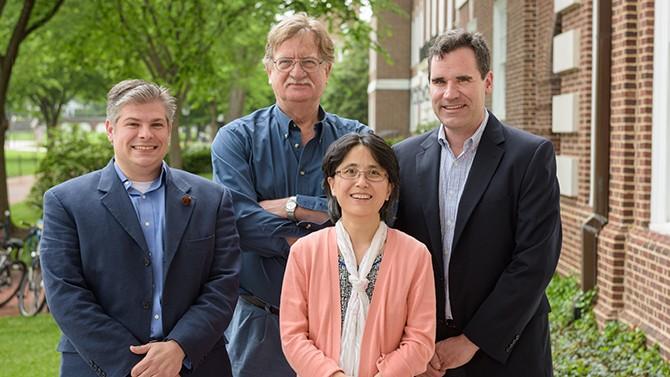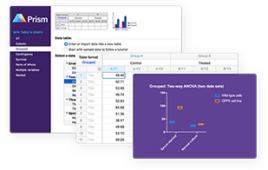
Joe Fox (right), professor of chemistry and biochemistry at the University of Delaware, collaborated with three UD colleagues on the work that has produced an important new catalytic tool. They are (from left) Joel Rosenthal (chemistry and biochemistry); Colin Thorpe (chemistry and biochemistry); and Xinqiao Jia (materials science and engineering). Source: Evan Krape/University of Delaware
You could think of bioorthogonal chemistry as a discreet valet or concierge that steers two world leaders to a private meeting without making noise or trouble along the way.
The valet is a catalyst of sorts, arranging the meeting to expedite a result that would not otherwise happen.
Bioorthogonal chemistry produces targeted reactions within living organisms that would not happen naturally. It is used in nuclear medicine, in imaging of cells, and in creating materials or adjusting the properties of materials already present.
Now, the collaborative work of four University of Delaware professors has given the valet an upgraded GPS and a turbo-charged engine, allowing for faster, more precise reactions that can be triggered by light or an enzyme and will have even more implications for medicine, engineering and other sciences. Their achievement is described in a newly published article in the Journal of the American Chemical Society.
“This paper is one I’m really excited about,” said UD’s Joseph Fox, a leader in the relatively young field of bioorthogonal chemistry. “It is something that will be influencing what we do for years to come.”
Fox is professor of chemistry and biochemistry and of materials science and engineering and also directs the UD-based National Institutes of Health Center of Biomedical Research Excellence on Molecular Discovery. He has worked for almost a decade on development of the tool now widely used in bioorthogonal chemistry – the reaction known as tetrazine ligation. Tetrazine ligations have produced reactions at record-setting speed.
Fox and his collaborators – professors Joel Rosenthal and Colin Thorpe of chemistry and biochemistry and Xinqiao Jia of materials science, biomedical engineering and the Delaware Biotechnology Institute – now have developed a process that triggers tetrazine ligation with red or near-infrared light or a tiny dose of the enzyme known as horseradish peroxidase.
Much work remains before this process could be used in a human being, Fox said. But the concept works and could produce useful applications in a wide array of procedures, including drug delivery and tissue engineering.
For example, the process would make it possible to change the properties of an injectable material once it has reached the inside of a diseased knee, Fox said.
He expects the new procedure to play a role in the “cancer moonshot,” Vice President Joe Biden’s initiative to promote research that will lead to better, more effective tools in the battle against cancer.
“One thing we’re hopeful this will allow us to do is to localize catalysts on a tumor and catalyze this reaction on the tumor as a way of dropping off drugs, as opposed to chemotherapy which is toxic throughout,” he said. “It will be part of the cancer story going forward.”
Each of Fox’s collaborators brought special expertise to the project. Thorpe, a biochemist, proposed the horseradish enzyme and brought expertise in kinetic and mechanistic analysis. Jia brought expertise in biomaterials, creating hydrogels and fibers. Rosenthal, an inorganic chemist, brought expertise in electrochemical and photochemical processes.




